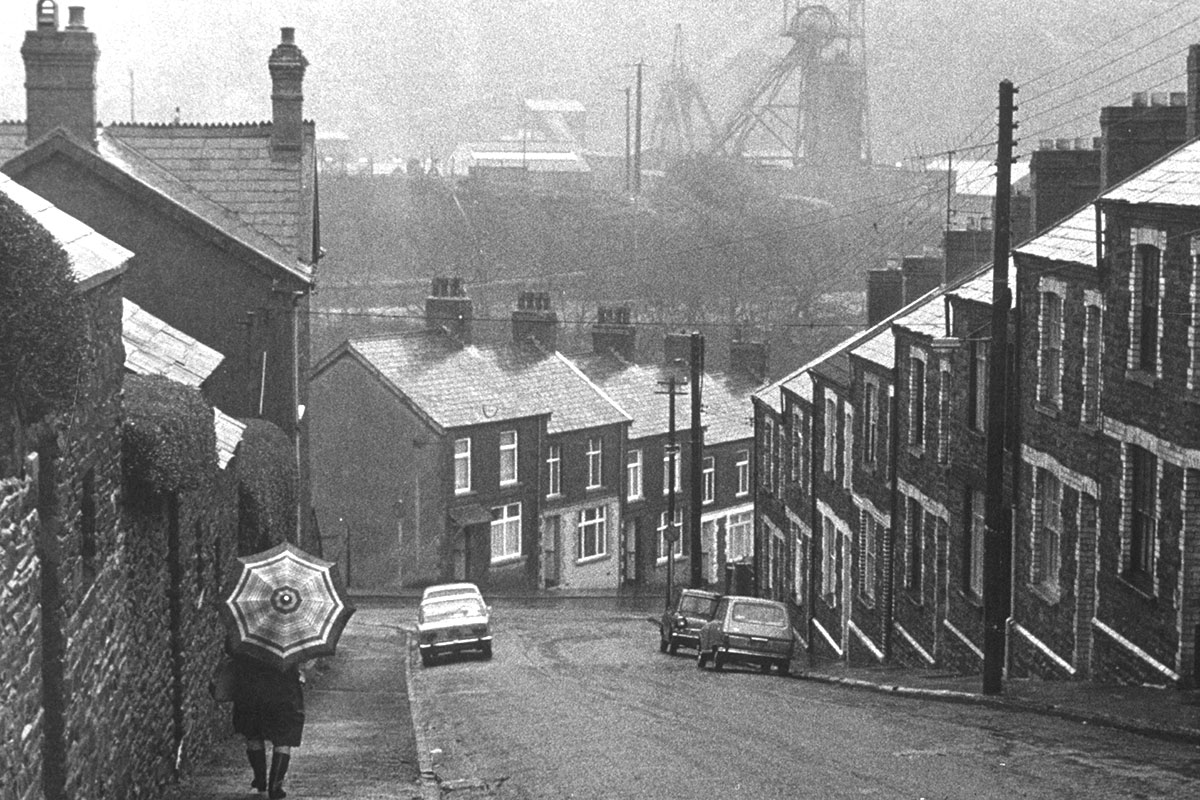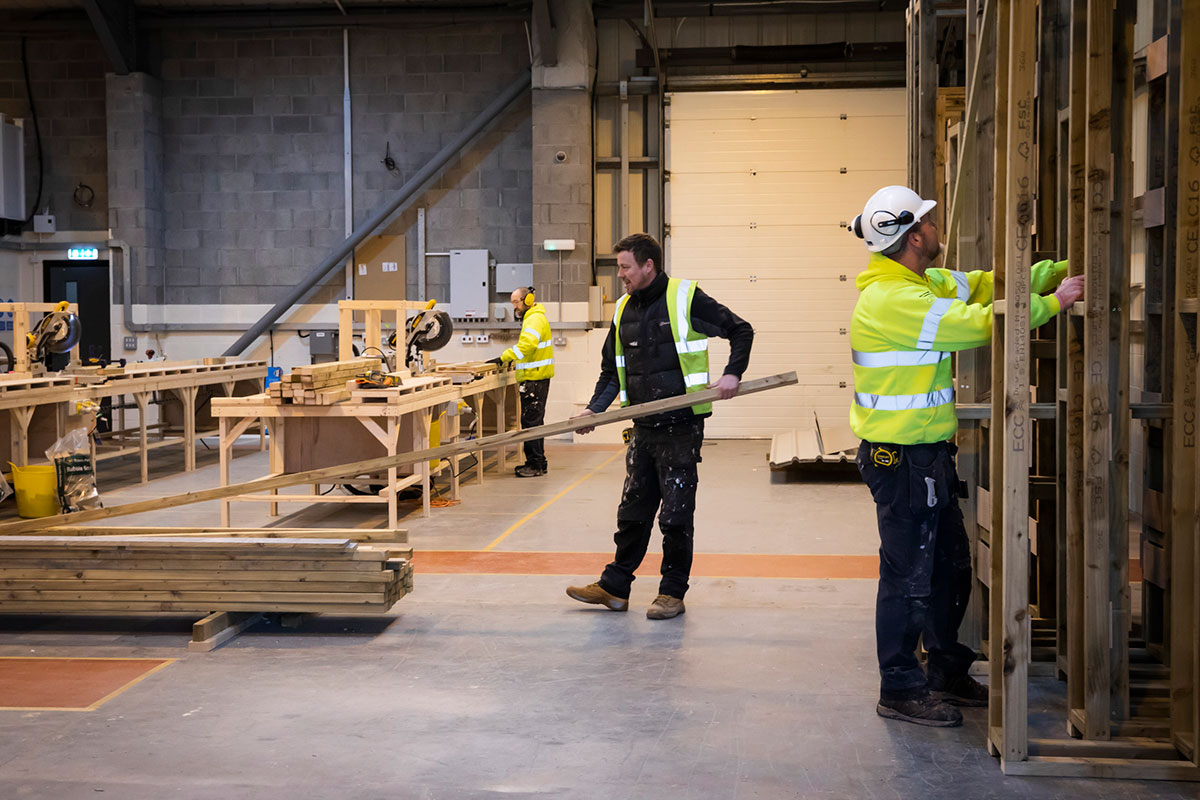You are viewing 1 of your 1 free articles
Will ending the Right to Buy breathe life into the Welsh housing dragon?
Last January, Wales followed Scotland’s lead and ended the Right to Buy in a bid to protect housing stock. As the number of homes being built for social rent falls, Darren Devine assesses whether it can reverse the decline of social housing. Photography by Rex Features and Mandy Jones
Terraced housing in a Welsh colliery town, 1981
According to its advocates, the Right to Buy democratised homeownership, extending it from the preserve of the affluent to aspirational working-class families who wanted a stake in properties they had invested their lives in.
But while Margaret Thatcher’s great social mobility experiment proved popular with the millions of new homeowners it created across the UK, it left the supply of local authority housing heavily depleted.
In Wales, by 31 March 2015 – nearly 35 years on from the introduction of the Right to Buy – the country had lost almost half (45%) of its entire stock of social housing.
Around 139,000 homes were sold under the Right to Buy and the later 1996 housing association measure, the Right to Acquire.
Statistics show that sales of social housing under the Right to Buy had slowed to a trickle by the time the policy was ditched in Wales – from 15,761 at the height of its popularity in 1982/83 to 538 in 2017/18.
And the last time Welsh councils sold more than 1,000 properties was more than a decade ago in 2007/08.
But still, the Welsh Labour government had decided enough was enough.
In 2016, Carwyn Jones, first minister at the time, used the party’s manifesto for the Assembly elections to announce that Welsh Labour would follow the lead set by Scotland and ditch the Right to Buy. As of 26 January this year, council and housing association tenants in Wales lost the right to buy their homes as part of a wider move to preserve and revive social housing in the country.
Andrea Lewis, deputy housing spokesperson at the Welsh Local Government Association, believes that the move was crucial to prevent the stock haemorrhaging any further.
“The cost of replacing that lost housing is going to be extortionate,” she tells Inside Housing. “It’s going to take quite some time. I wouldn’t be surprised if it takes decades to replace it again.”
The Welsh government says it is investing £1.7bn to build 20,000 new “affordable homes” over the course of this Assembly, which runs until 2021. Up to 13,500 of these will be built by housing associations and councils, with the vast majority available to rent. Developers will build the remaining 6,500 for the shared equity scheme Help to Buy.
In the meantime, the Welsh government has also commissioned a review of the supply of affordable housing, which is due to report its findings next month.
Ms Lewis says that alongside the abolition of the Right to Buy, Swansea is trialling a range of measures to tackle the social housing deficit, including using Section 106 agreements and open market purchases to boost supply.
Building work is set to start on up to 150 new council homes by 2022, and there are plans for a further 550 – the first significant programme in the city for a generation.
These numbers are dwarfed by the properties lost to the Right to Buy in Swansea – 3,500 since 2001, says Ms Lewis, who adds that there are 4,000 people on the council’s housing waiting list.
But she hopes the measures represent the early stages of a revival: “We will do whatever we can and be as ambitious as we can to deliver as much as we can over the next few years, and continue to do that.
“We are struggling with an ageing population and the population is growing. So not only do we need more homes, but we need accessible homes as well for our older generations to move into, so they can downsize and free up family homes.”
Matt Dicks, director of the Chartered Institute of Housing Cymru, believes that, taken on its own, abolishing the Right to Buy will do little to reverse the decline of social housing.
Instead, Mr Dicks thinks that the Welsh government was forced to act because it did not make sense to invest in new social housing while allowing existing properties to be sold off. “I don’t think anyone ever suggested it was the Nirvana or the promised land that would end the housing crisis,” he says.
The cost and availability of land alongside skills shortages in council planning departments are among the factors that have contributed to what Mr Dicks describes as Wales’ “chronic under-supply” of new social housing. The Welsh government is pouring £43m through its Innovative Housing Programme.
This is a pot of Welsh government cash, available to councils, housing associations and private developers, worth £90m over three years, that is set aside for novel solutions to Wales’ affordable housing problems.
“The cost of replacing that lost housing is going to be extortionate. I wouldn’t be surprised if it takes decades” – Andrea Lewis, deputy housing spokesperson, Welsh Local Government Association
One solution proposed is offsite modular building, in which the different parts of the house are constructed in factories and brought together on site.
North Wales housing association Cartrefi Conwy has just opened its own modular factory in Holyhead, on Anglesey, where timber-framed properties are built in less than two weeks.
In Swansea, Ms Lewis reveals that the council is looking at using redundant sites like car parks for housebuilding – another option for circumnavigating the high costs of land.
Some local authorities in Wales took steps to protect their housing stock before the government formally abolished the Right to Buy.
Among them were Anglesey, Carmarthenshire, Swansea, Flintshire, Denbighshire and Cardiff, which all suspended the Right to Buy unilaterally.
Carmarthenshire was the first council to act, in January 2015. The following year the west Wales authority promised 1,000 new affordable homes by 2021.
The council says it has already passed the halfway mark and 500 families have benefited from a £25m investment in low-cost homes.
Tegwen Devichand, who was Carmarthenshire Council’s cabinet member for housing when the Right to Buy was suspended, says that many former council houses were ending up in the hands of private landlords.
She claims that the policy was meant to use the cash generated from sales to build new properties, but these never materialised.
The heavy discounts available under the Right to Buy – which were as high as 60% (a maximum of £75,000 in cash terms) for some – meant that sales simply didn’t generate the cash needed to make the ‘one-for-one replacement’ approach work.
Properties are built in less than two weeks in Cartrefi Conwy’s modular factory
Ms Devichand says that Carmarthenshire suspended the Right to Buy out of concerns that “stock was going out” and “people on the lowest income scale couldn’t afford to buy houses”. In March last year the BBC revealed that at least 60,500 households were on social housing waiting lists in Wales.
But tackling Wales’ social housing shortage doesn’t have to concentrate exclusively on new builds. Figures from ITV News last year suggested that 43,028 homes in Wales are empty, and around 40% are vacant for more than six months.
Official figures show that 4,158 social housing properties were empty at the end of March 2018.
Meanwhile, research by the BBC in 2017 suggested that less than 1% of privately owned empty properties in Wales were brought back into use by councils.
“Quite often the people who own those homes don’t know where to turn. They don’t know who to have a discussion with and they don’t know what to do themselves” – Aaron Hill, public affairs manager, Community Housing Cymru
Some associations in Wales are now trying to help revive empty properties. Caerphilly-based United Welsh is involved in two projects – Homestep Plus and Empty Homes Wales – which are designed to bring vacant properties back into use.
Homestep Plus sees United Welsh identify and buy empty properties before refurbishing them and selling them on at 70% of the asking price.
Empty Homes Wales works with property owners to bring vacant houses back into use, by helping them overcome problems such as financial barriers and inexperience of leasing.
“Quite often the people who own those homes don’t know where to turn,” explains Aaron Hill, public affairs manager at Community Housing Cymru. “They don’t know who to have a discussion with and they don’t know what to do themselves.”
The numbers suggest that the Welsh government pulled the plug on a policy that had already done its damage. Indeed, social housing stock in Wales was almost cut in half by the time the Right to Buy was abolished.
The move to abolish the policy may well be a largely symbolic one, and more is certainly needed to revive the nation’s housing supply. But if the overall mission is to replenish the stock of social housing in Wales, it is a step in the right direction.














